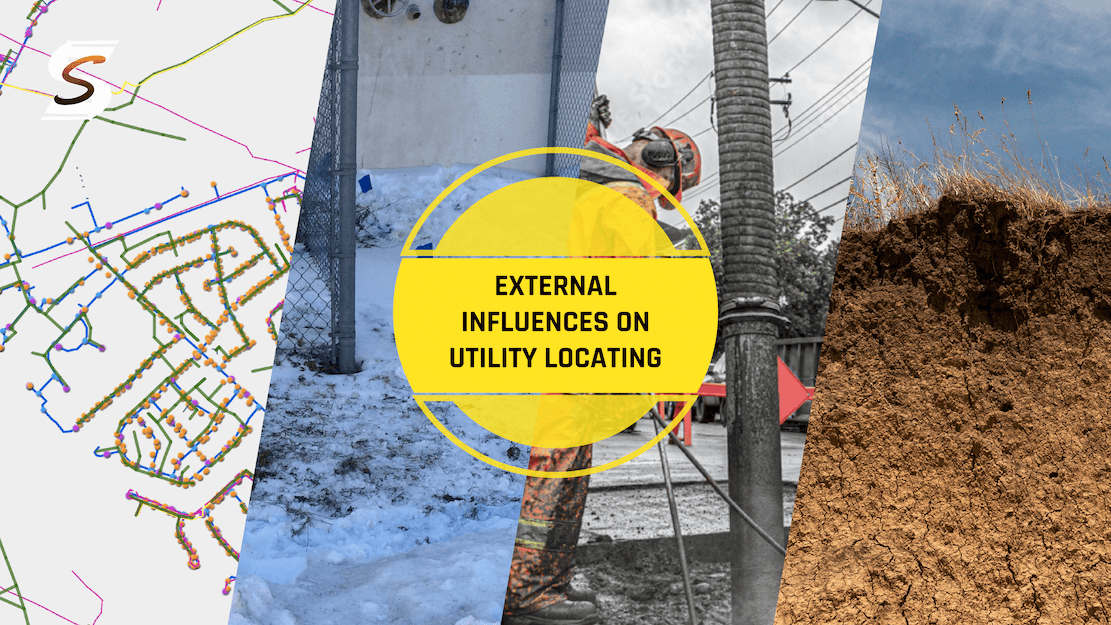
Accurately identifying the location of utility lines is one of the most crucial aspects of any construction or excavation project. Utility locating involves detecting and marking the position of underground utilities to prevent damage and ensure safety during construction. Several factors influence the accuracy of utility locating, and understanding these elements is essential for successful project outcomes.
WEATHER
Weather conditions profoundly impact utility locating accuracy. Fluctuations in temperature and humidity can alter signal strength, making it easier or harder to detect utility lines. For instance, metal pipes can expand and contract with temperature changes, affecting their detectability. Heavy rain or snow can obscure or bury utilities, further complicating the detection process. Every year after snowstorms I see the tops of buried marking flags, which is another reminder that flags, while legally required, aren't a great way to keep track of utilities. That’s why Utilocate has a built-in sketch tool to mark up and record utility maps. This experience underscores the importance of scheduling utility locating tasks during optimal weather conditions whenever possible to ensure the highest accuracy.
CONDITIONS
The nature of the soil, including its moisture level and thickness, significantly affects the accuracy of locating buried utilities. Sandy, dry soil typically allows for easier detection of underground utilities, whereas wet, muddy soil presents more challenges. Diverse soil conditions can be encountered across various projects. For example, working on a site with clay-rich soil can severely impede your ability to locate utilities. Conducting comprehensive soil analyses before starting any project can enhance detection accuracy, ultimately saving time and resources. Although such analyses may not be feasible for most public locates, pre-planning processes, like those implemented in Chicago, could make this more commonplace for private locates.
DEPTH
The depth at which utilities are buried directly affects the ease of detection. As the depth increases, the signal from the buried utility weakens, making it more challenging to locate accurately. Advanced equipment and techniques are often required to detect utilities buried at greater depths. Investing in state-of-the-art technology is crucial for detecting deeply buried utilities and avoiding costly excavation errors. I recall one instance on a project where the gas pipes we were trying to find were buried over 10 feet deep. Using a hydrovac to pothole helped establish depth and align with the Quality Level A (QL-A) standard, ensuring precise location and reducing the risk of damage.
INTERFERENCE
The material and size of utility lines play a critical role in their detectability. Metal pipes and cables are generally easier to locate than plastic ones due to their conductive properties. Larger utilities tend to produce stronger signals, making them easier to detect compared to smaller ones. Utilizing advanced detection equipment that can differentiate between various materials enhances locating accuracy. It’s usually easier to identify a large metal water main, than smaller, non-metallic gas lines that require more precise equipment to locate. Interference from nearby electrical sources, buildings, and other underground utilities can affect the accuracy of utility locating. Electrical interference can disrupt the signals used to detect utilities, leading to false readings or missed detections. Conducting thorough site assessments to identify and mitigate sources of interference is crucial. For example, on a site adjacent to a high-voltage substation, significant signal interference was encountered. By adjusting equipment settings and using specialized filters, the utilities were successfully located. Understanding these factors is essential for ensuring the safety and efficiency of construction and excavation projects. By leveraging advanced technology, maintaining meticulous records, and drawing on extensive field experience, the risks associated with underground utilities are significantly reduced, leading to successful and safe project outcomes. That’s another reason I’ve pushed our development team to ensure Utilocate is capable of bringing in mapping, from as many platforms as possible.
MAPPING
The accuracy of existing maps and historical records of utility installations can significantly influence the utility locating process. Outdated or inaccurate maps can lead to incorrect assumptions about the location of utilities, increasing the risk of damage during excavation. Verifying and updating records before beginning a project can enhance the accuracy of utility locating efforts. Regularly updating utility maps and records to reflect any changes or new installations is essential. Just last year we had a customer who was working as a subcontractor where they were provided outdated maps that led to a near-miss incident with a gas line that was not marked correctly. Updating and cross-referencing records help prevent potential hazards.
CONCLUSION
In conclusion, the process of utility locating is complex and influenced by numerous variables. Weather conditions, soil nature, utility depth, material and size, the accuracy of historical records, and potential interference all play pivotal roles in determining the accuracy of utility detection. Professionals in the field know that accurate utility locating is not just about avoiding costly mistakes—it's about ensuring the safety of everyone involved in the project. By adopting a comprehensive approach that blends technology, expertise, and diligent planning, the challenges associated with underground utilities can be effectively managed, ensuring that construction and excavation projects proceed smoothly and safely.
Field experience repeatedly demonstrates the critical importance of these factors and I really value any time I can get out with clients and users. From dealing with unexpected weather changes to navigating challenging soil conditions and handling deeply buried utilities, each project provides valuable lessons. These experiences highlight the need for adaptability, thorough preparation, and the use of cutting-edge technology to achieve the best possible outcomes in utility locating.
Ultimately, the goal is to create a safer, more efficient environment for construction and excavation activities. This is achieved through a deep understanding of the factors influencing utility locating and the continuous application of best practices in the field. As technology advances and methodologies improve, the ability to accurately locate utilities will only continue to enhance, paving the way for even safer and more efficient project execution.
Share this Post











